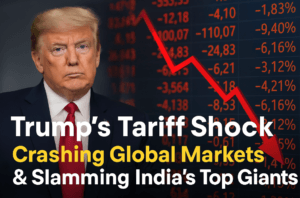Trump’s Tariff Shock: 7 Alarming Ways It’s Crashing Global Markets & Slamming India’s Top Giants
Donald Trump’s aggressive tariff policies have sent shockwaves through the global economy, sparking fears of a full-blown trade war. His decision to impose steep import tariffs, especially on Chinese goods, has triggered sharp retaliations, unsettling financial markets worldwide. Asian indices tumbled, with Japan’s Nikkei and China’s Shanghai Composite suffering significant losses, while Indian markets saw Rs 14.2 lakh crore erased in a single day.
Global recession concerns have intensified, with sectors like IT, metals, and automobiles taking heavy hits due to their U.S. exposure. Major Indian conglomerates like Tata Group and Reliance Industries experienced massive market value erosion. Foreign investors pulled out over Rs 9,000 crore from Indian equities, though domestic institutions attempted to stabilize the markets. Economists warn of potential stagflation if the trade tensions escalate. Despite the turbulence, some experts believe India’s strong domestic fundamentals may offer a cushion against the global slowdown.

Trump’s Tariff Shock: 7 Alarming Ways It’s Crashing Global Markets & Slamming India’s Top Giants
Global economists and investors are increasingly alarmed by the potential fallout from Donald Trump’s aggressive tariff strategies, which have reignited fears of a full-blown international trade war. His decision to impose reciprocal tariffs on imports—particularly targeting China—has triggered a cycle of retaliation. After China responded with 34% tariffs on U.S. goods, Trump threatened even steeper penalties, including duties as high as 50% on Chinese products. These escalating tensions have sent shockwaves through global markets, raising concerns about prolonged economic instability.
Asian Markets in Turmoil
The ripple effects of these policies were felt sharply across Asian financial markets. Japan’s Nikkei 225 index nosedived nearly 8% at one point before closing 6% lower, while Hong Kong’s Hang Seng plummeted 9.4%. China’s Shanghai Composite and South Korea’s Kospi also slumped by 6.2% and 4.1%, respectively. India’s stock markets mirrored this chaos, with the BSE Sensex and Nifty50 both plunging 5% during trading hours before a partial recovery. The sell-off wiped out a staggering ₹14.2 lakh crore from Indian market capitalization in a single day—marking one of the worst losses in Sensex history.
Roots of the Market Collapse
Experts link the crash to growing anxiety over a potential U.S. recession and a synchronized global slowdown. Investors hastily retreated from sectors with heavy exposure to American markets, such as automobiles, IT services, pharmaceuticals, and metals. The Tata Group, with significant U.S. operations, saw ₹2.4 lakh crore erased from its market value, while Reliance Industries lost ₹1.3 lakh crore. Foreign institutional investors withdrew over ₹9,000 crore from Indian equities, though domestic institutions injected ₹12,122 crore—signaling contrasting confidence levels.
Global Recession Risks
Prominent firms like JP Morgan and Goldman Sachs have raised recession forecasts, warning that Trump’s tariffs could spur stagflation—a toxic blend of stagnant growth and rising inflation. BlackRock CEO Larry Fink noted that many corporate leaders already view the U.S. as recession-hit, cautioning against hopes for aggressive Federal Reserve rate cuts amid persistent inflation. The S&P 500’s 10.5% two-day drop, erasing nearly $5 trillion in value, underscored the panic. Despite this, Trump framed the turmoil as a necessary sacrifice for future economic strength, urging resilience among Americans.
India’s Relative Resilience
Amid global uncertainty, India’s economy appears comparatively insulated. Analysts highlight its reliance on domestic demand, structural reforms, and falling oil prices as stabilizing factors. Narendra Solanki of Anand Rathi Shares projects a Nifty target of 26,000 within a year, emphasizing India’s robust long-term prospects. A. Balasubramanian of Aditya Birla Mutual Fund echoed this optimism, pointing to strong fundamentals and potential inflation relief from cheaper oil, which could pave the way for growth-boosting rate cuts.
Sector-Specific Strains
Companies dependent on U.S. markets bore the brunt of the sell-off. Tata Consultancy Services (TCS) and Tata Motors, which owns Jaguar Land Rover, lost ₹97,100 crore and ₹33,800 crore, respectively. Metal giants Tata Steel and Hindalco saw valuations drop by ₹31,300 crore and ₹22,200 crore, reflecting fears of dwindling global demand. Notably, six Sensex heavyweights—Infosys, L&T, Reliance, Tata Motors, TCS, and Titan—hit 52-week lows, with 22 BSE 100 stocks touching annual lows.
Looking Ahead
While the immediate outlook remains fraught with volatility, India’s domestic-driven economy and policy agility offer a buffer against external shocks. However, the broader global landscape hinges on whether trade tensions escalate further or give way to diplomatic resolutions. For now, markets worldwide brace for more turbulence as policymakers and investors navigate uncharted economic terrain.
You must be logged in to post a comment.